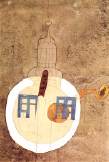

The art school of Szentendre, a town by the Danube, was established in 1928. The prevailing style of the Szentendre school was that of the Roman school, but neo-classicist and naive styles (Jenő Paizs-Goebel: Golden Age) were also present whereas pictures of Jenő Barcsay showed towns and landscapes in a structural approach (Hilly Landscape, 1934).
The art of Szentendre was present not only in works of the art school, and there were several painters of different generations in Szentendre who represented different styles. Béla Czóbel, a former member of The Eight, used to work in Szentendre in summer months who had by that time developed an unaffected style of his own (In the Atelier, 1922). Works of Lajos Vajda were inspired by motifs, buildings and folk-art of towns and their neighbourhoods. Baroque facades of peasant houses (Houses in Szentendre with Crucifix, 1937), Serbian icons and self-portraits (Self-portrait with Hold-up Icon, 1936) appear in his delicate charcoal-drawings. The path taken by Vajda who died at young age was then taken by Dezső Korniss: grotesque pictures inspired by Hungarian folk-art were presented in geometric composition (Wedding of Crickets, 1948). Works of Imre Ámos were rooted in Jewish culture: religious symbols appeared in his pictures (Cabbalist, 1938) but the idyllic atmosphere was soon expelled by surrealistic visions anticipating the tragic fate of the artist (Dark Times, 1940).
Szentendre remained after 1945 what it had always been: a town of artists. Lots of artists have worked there up till now, too, and museums have been opened to honour major artists (e.g. Barcsay, Czóbel and Vajda).